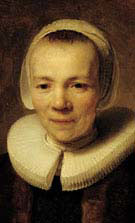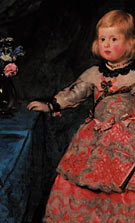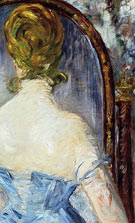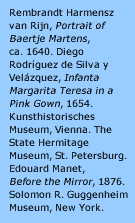 |
 |
 |
 |
|
| Connecting Museums at the Solomon R. Guggenheim Museum, New York |
||
A trio of great painters—Rembrandt, Velázquez, and Manet—offers here a trio of women at three very different stages of life and from three totally separate worlds. From the 1640s, we have a sober wife and mother in an Amsterdam household; from the 1650s, the two- or three-year-old daughter of the King of Spain; and from the 1870s, a high-class Parisian courtesan. Compared to the instant dazzle of the Velázquez and Manet, Rembrandt's Portrait of Baertje Martens speaks in such a quiet voice that it might almost be overlooked. Somber to the point of austerity, it offers little to divert us from the aging woman's steadfast pose and thoughtful, immobile face. The setting is luminous but empty, a breathing atmosphere of light and shadow without a trace of a domestic setting. Her clothing, which permits the exposure of only hands and head, is generic for a proper and prosperous Dutch housewife. And the color remains within Rembrandt's signature range of old-master browns, aging even further the pink flesh of her veined hands and wrinkled face. The sitter was no stranger to Rembrandt. She is Baertje Martens, the wife of frame maker Herman Doomer, whose son Lambert worked as an apprentice in Rembrandt's studio. Around 1640, Rembrandt, in fact, painted not only her portrait but also that of her husband (now at the Metropolitan Museum of Art, New York), providing the couple with a familiar portrait duo of husband and wife, or mother and father. The Doomers were certainly close to the artist, and he may well have painted their portraits more as an act of friendship than of commerce, a personal gift that would preserve their images for posterity, as ancestral family effigies. It is telling that Baertje, in her will, left the portraits to her artist-son on the condition that he make copies of the two paintings to give to his siblings. Her portrait, then, was intended to capture her features and character so that her descendants might know her. Any of Rembrandt's contemporaries could have painted such a likeness, which fits into a conventional seventeenth-century Dutch formula, but few, if any, could have given this wife and mother so specific a sense of personality and interior life. Because of her totally static and formal pose—her hands clasped, her wedding ring just visible, her posture firm and simple—we gravitate quickly to what defines her as an individual, seeking her out above the respectable restraints of her immaculate white ruff. There we find a woman whose character we feel we can slowly reach through her eyes and expression. Our empathy with the private worlds of Rembrandt's sitters is so penetrating that words seem both impossible and superfluous. In this portrait, we might intuit a woman who is quietly content, alert, and practical, perhaps the stable core of the Doomer family. It is Rembrandt's genius to persuade us that we have a sustained and intimate relationship with a unique human being. In Madrid about a dozen years later, Philip IV's court artist, Velázquez, painted Infanta Margarita Teresa in a Pink Gown, a very different kind of portrait, that of the king and queen's first child. Born in 1651, the infant began her royal career by posing for Velázquez every few years, a sequence that traces her childhood until her marriage, at the age of fifteen, to her cousin Leopold, the Emperor of Austria (which accounts for the painting's home in the Kunsthistoriches Museum, Vienna). In fact, she was to make her most famous pictorial appearance in 1656, at the age of five, as the central figure in Velázquez's Las Meninas. Here, in Margarita Teresa's first portrait, which has been dated 1653 as well as 1654, her claim to royal power is immediately confirmed by Velázquez. If we looked at nothing but her blond, unadorned hair and pudgy pink cheeks, we might find only a beguiling child, but this simple human fact has been transformed into a dynastic image that determines her royal destiny. In the most unchildlike way, this miniature monarch stands, immobile, on a carpeted dais, one hand holding a fan like a scepter, the other elegantly poised on a table covered with a rich blue cloth. Behind her, as in a theatrical performance, a large curtain is raised above her body, still small but already a majestic presence. In contrast to Rembrandt, who gives us almost nothing to look at but Baertje Martens's face and private feelings, Velázquez offers such an abundance of visual diversions that we may quickly forget the royal heiress and simply wallow in the sumptuous pleasures of the world she has inherited. For one, there is Margarita Teresa's spectacular clothing, a full-skirted salmon-pink dress, cooled by silver-gray brocaded patterns and further adorned by pink bows at waist, wrist, and shoulder. For another, there is her jewelry, which, with a necklace, a brooch, and, crossing her chest, a chain like a bandoleer, adds gold to the silver of her costume. And in a further visual seduction, Velázquez includes a modest bouquet of roses, irises, and daisies in a small glass vase appropriate to the sitter's size. For all its apparent rigidity, this portrait conveys the sense of an instant. Even without the white rose that seems to have just fallen from its stem to the table, the virtuoso swiftness of the artist's brushstroke endows everything with a flickering, momentary life. A few strokes of white paint on the vase capture the reflection of a window. The complex patterns of the oriental carpet on the dais live a quietly animated life of their own. The elaborate hems of the infant's flared skirt seem to ripple with a vitality that defies the stiffness of the little girl's pose. Nowhere, in fact, does our eye rest, seesawing from one fabric to another and, most particularly, from the royal portrait, center stage, to an exquisite still life, on the left, which might be enjoyed as a totally separate painting. It was exactly such qualities of an immediate, vibrant reality—where brushwork suggests constant movement and where different things, whether people or inanimate objects, compete for our attention—that made Velázquez a god for Manet. The point is borne out in the most recent of the three paintings here, dated 1876. No longer a traditional portrait, Manet's Before the Mirror offers instead a glancing, fragmented image of what at first looks like an anonymous type—a young blond woman seen only from behind, her face concealed from us—but nevertheless feels like the record of a particular person at a particular moment. In fact, she has been convincingly identified as Henriette Hauser, the famous courtesan who was mistress to the Netherlands' Prince of Orange and who also posed around the same time for Manet's Nana (1877), a depiction of another courtesan—Emile Zola's fictional character—wearing a similar blue-and-white corset. Before the Mirror presents a rapid glimpse of a bare-shouldered woman adjusting her corset in front of a cheval glass or, in French, a psyché, thus putting the spectator in the role of a Peeping Tom who, in a premodern world, would be observing a mythological Venus contemplating her beauty in a mirror. Manet's painting offers unexpected access to this domain of feminine privacy and vanity, a domain the artist often depicted in more explicitly sexual terms, most famously in his Olympia (1863). In Before the Mirror, painted in the year of the Impressionists' second group exhibition, the moment is so fleeting that the erotic charge is almost lost. Now, Manet pushes Velázquez's dazzlingly rapid, virtuoso brushwork to even further extremes, allying the Spaniard's art to the goals of Impressionism. We can barely discern the presence of what looks like a bouquet of flowers in the right-hand corner, and the mirror's glistening reflections seem to absorb the bare flesh and undergarments of this modern goddess of love. The walls of the room itself are transformed into a mottled, luminous illegibility, suggesting perhaps wallpaper behind the mirror and, at the right, a pale-blue curtain or shade that reflects the elegantly cool color harmonies of the corset. So accidental is this snapshot of a woman at her toilette that everything looks arbitrarily cropped. Both the mirror and the woman are presented as incomplete parts, to be completed in the viewer's space outside the frame. As Zola would have put it, this is a "slice of life." But there are elements of mystery here as well. Like Alice's adventures through the looking glass, the woman seems almost to be disappearing into the shimmering world of her reflection, like Psyche in her mirror. It may be no surprise to learn that in 1932, the centenary of Manet's birth, this painting may have sparked the imagination of none other than Picasso, who that year painted Girl before a Mirror as well as other works that include a blond woman reflected in a psyché. Did Manet's painting provide Picasso with the objective theme he could transform into an invisible, internalized world of feminine mysteries? At that time, this Manet already belonged to Justin K. Thannhauser, a dealer and avid patron of Modern art who, in 1932, was organizing Picasso retrospectives for Paris and Zurich. Decades later, thanks to Thannhauser's gift of his magnificent collection, Manet's Before the Mirror, not to mention thirty-two Picassos, ended up at the Guggenheim Museum. —Robert Rosenblum |



